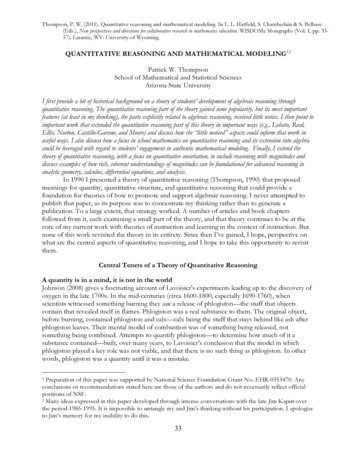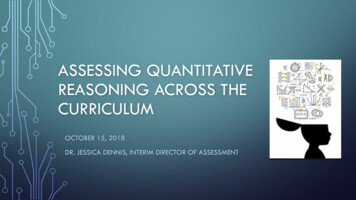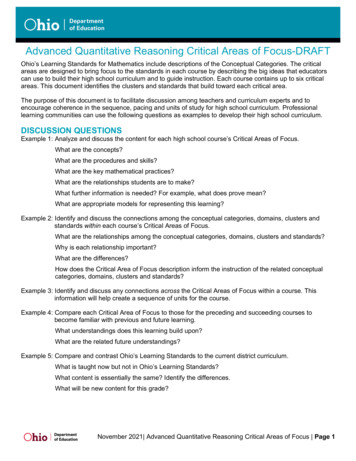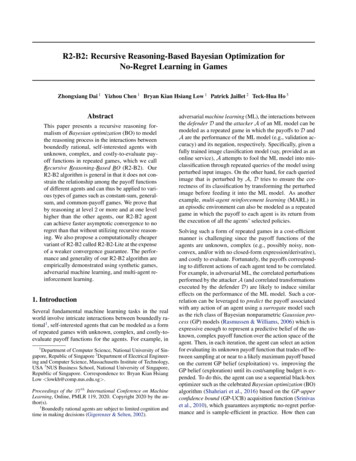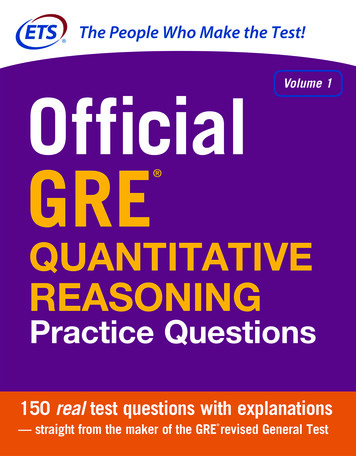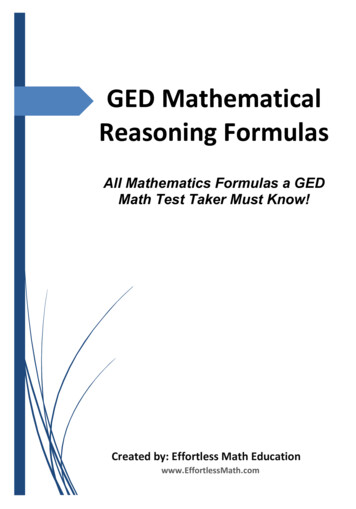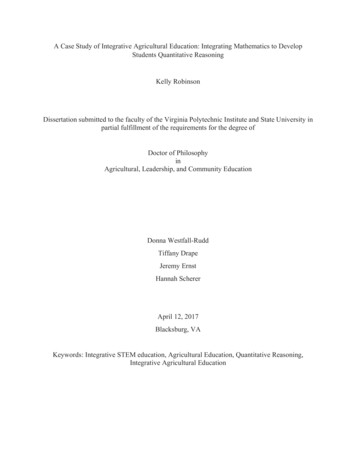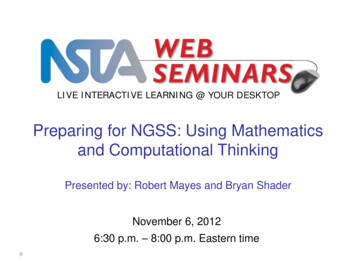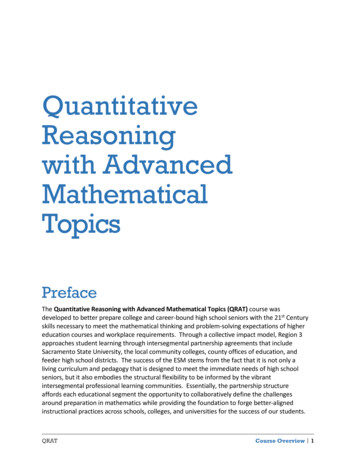
Transcription
QuantitativeReasoningwith AdvancedMathematicalTopicsPrefaceThe Quantitative Reasoning with Advanced Mathematical Topics (QRAT) course wasdeveloped to better prepare college and career-bound high school seniors with the 21st Centuryskills necessary to meet the mathematical thinking and problem-solving expectations of highereducation courses and workplace requirements. Through a collective impact model, Region 3approaches student learning through intersegmental partnership agreements that includeSacramento State University, the local community colleges, county offices of education, andfeeder high school districts. The success of the ESM stems from the fact that it is not only aliving curriculum and pedagogy that is designed to meet the immediate needs of high schoolseniors, but it also embodies the structural flexibility to be informed by the vibrantintersegmental professional learning communities. Essentially, the partnership structureaffords each educational segment the opportunity to collaboratively define the challengesaround preparation in mathematics while providing the foundation to forge better-alignedinstructional practices across schools, colleges, and universities for the success of our students.QRATCourse Overview 1
AcknowledgementsAuthorsDeb Stetson, Mathematics Project, California State University, SacramentoHeidi Espindola, Placer County Office of EducationJennifer Graziano, Sacramento City Unified School DistrictKim Elyce, California State University, SacramentoMarsha King, Sacramento County Office of EducationPitt Turner, Sierra CollegeRavin Pan, California State University, SacramentoSarah Ives, California State University, SacramentoSpecial AcknowledgmentsWe wish to express our deep appreciation to Charlotte Van Wagner for the many hoursspent designing this curriculum and for the excellent result. We also gratefullyacknowledge Mandy Davies and Joy Salvetti for their leadership and stewardship inbuilding and maintaining the partnerships necessary to create this intersegmentalcurriculum and professional learning program.The content of Quantitative Reasoning with Advanced Mathematical Topics was developed by an intersegmentalpartnership between Sierra College, Sacramento State University, the Los Rios Community College District, and theSacramento and Placer County Offices of Education and area high school districts. Funding was provided by theCalifornia Community Partnership Initiative and the California Mathematics Readiness Challenge Initiative.2 Course OverviewQRAT
IntroductionCourse Purpose and GoalsThis course is designed to strengthen students’ mathematical foundation and preparestudents to be college and career ready. The goal of the course is to deepen conceptualunderstandings of mathematical theory, skills and strategies. The course is designed toincorporate National Common Core Standards for Mathematical Practice and is aligned withspecific high school content standards listed in the California Common Core State Standardsfor Mathematics (CCCSS-M). Utilizing real-world applications, this course serves both collegeand career bound high school seniors.The purpose of this course is to fulfill the need to provide more math options for high schoolseniors to take a mathematics course that better prepares them for transition into college-levelwork or workplace expectations. The target student cohort is seniors who are interested in amajor that heavily depends on science, technology, engineering, and/or mathematics (STEM)and other math intensive fields. This course is designed to better prepare students for therigorous mathematics requirements in those fields. It is also intended for high school seniorswho have completed Algebra II or Integrated Math III and who have met the CAASPP/EAPstandards but do not wish to take a precalculus or calculus course in high school.The development of this course was predicated on the idea that students who had previouslyconsidered themselves as unsuccessful in mathematics could learn and thrive in anenvironment which fosters engagement and conceptual learning. With a focus on depth, notbreadth, students would master mathematical content and be able to transfer their skills tocollege and to career pathways. Lessons and tasks provide students with opportunities to solvechallenging problems in which they gather, analyze, and evaluate information, work effectivelyin groups to make decisions using critical reasoning skills, as well as opportunities tocommunicate concisely through written and oral language. Throughout the course, studentsincrease their perseverance to make sense of and to solve real-world and theoreticalmathematical problems, develop a greater perspective of underlying structures of mathematicsand how they connect mathematical topics. Students gain an appreciation of mathematics andits applications and develop a growth mindset towards mathematics that enables the studentto continue to persevere through problem solving in the quantitative reasoning nature ofcollege-level courses.QRATCourse Overview 3
Major Student Outcomes Develop a growth mindset towards mathematics that enables the student tocontinue to persevere through problem solving in higher level math courses. Become better problem solvers. Build critical thinking skills. Increase their perseverance to make sense of and to solve real-world andmathematical problems. Deepen their understanding of underlying structures of mathematics. Gain appreciation of mathematics and its applications. Improve their ability to communicate their mathematical thinking. Develop their ability to work effectively as a member of a team.Course Objectives Demonstrate the Standards for Mathematical Practice when engaged in mathematics. Flexibly apply problem solving strategies (e.g., guess and check, logic/deductivereasoning, tables and lists.) to contextual situations to deepen conceptualunderstandings of the structures and applications of mathematics. Analyze the information imbedded in different types of contextual problems anddetermine what data is given and what assumptions can be justified. Identify and assess the importance of ambiguities and complexities within a problem. Strengthen number sense and procedural fluency. Make connections between numeric and algebraic expressions and representations. Examine and apply families of functions including: linear, quadratic, exponential,logarithmic, absolute value, and piece wise. Make connections between conceptual categories of mathematical content. Utilize understanding of linear and exponential functions in financial contexts. Reflect on their work and edit for clarity and accuracy. Make generalizations based on observations and repeated reasoning. Communicate reasoning verbally and in writing. Provide an appropriate level of justification in an organized viable argument, free fromlogical and arithmetical errors. Work collaboratively within small groups.4 Course OverviewQRAT
Course Outline/Sequence of LearningUNIT 1 Developing the Mathematical PracticesThis unit establishes a foundation for the rest of the course, stressing skills such asquantitative reasoning, the analysis and use of structure and repeated reasoning, andperseverance in solving traditional as well as nontraditional problems. Students deepentheir understanding and application of a variety of problem solving strategies. Eachproblem requires that students engage in multiple standards of mathematical practiceas outlined in the California Common Core State Standards for Mathematics (CCCSSM). This unit also provides opportunities and support for students to realize that theycan learn mathematics by conjecturing, investigating and justifying. In addition,students will develop team-building skills, learn to work effectively in groups andenhance their verbal and written mathematical communication skills. Problem solvingskills will be used throughout the course.To extend student content knowledge into a new area of mathematics, this unitexplores topics in graph theory and number theory. These tasks require students to takea contextual situation and represent it as a mathematical diagram that can be analyzedto identify specific conditions using information about edges and vertices. Studentsexplore Euler circuits and paths and the role that edges and vertices play in them.Students informally derive Faulhaber’s Formula for degrees one, two, and three.UNIT 2 Algebraic Foundations for Higher MathematicsThe foundational approach of the course, in which students recognize and extendnumeric patterns to generalize algebraic concepts, is established in this unit by anextension of linear and quadratic functions. The differences between discrete andcontinuous domains are explored through the transition between patterning andalgebraic representations. Extending and deepening their knowledge from previousconcepts to topics in number theory and calculus, students generate quadratic andlinear finite difference tables which emphasize the hidden structure in polynomialsequences, laying the foundation for derivatives of polynomials and the FundamentalTheorem of Calculus. In addition, students explore the sum of arithmetic sequencesusing Gauss’ method to derive the explicit formula for sequences with linear differences,paving the way for future exploration of polynomials and exponential functions.Students also make connections between composition of functions andparameterizations.UNIT 3 Complex Numbers, Polar Coordinates and VectorsThis unit introduces complex numbers and operations involving complex numbersusing the context of polynomial functions with imaginary solutions. Students find theconjugate of a complex number and discover its connection to moduli and quotients.QRATCourse Overview 5
Students study connections between arithmetic operations and the graphicalrepresentation of complex numbers. They also develop an understanding of theconnection between complex numbers represented by rectangular coordinates, polarcoordinates, and vectors.Note: This unit is a stand-alone unit and is movable within the remaining units. It isplaced here because complex numbers are connected to roots of quadratic functions.Alternatively this unit may be addressed after Unit 7, Unit 8, or Unit 9.UNIT 4 Polynomial and Rational FunctionsStudents deepen their understanding of polynomial functions and their graphs. Theyrecognize and compare key features of these including symmetries, end behaviors,intercepts, and extrema (both global and local). Students explore and utilize the concept ofRolle’s Theorem when identifying local behaviors. They extend these concepts to applythem to rational functions in general, adding the consideration of vertical and horizontalasymptotes, limits, and the behavior of graphs as they approach asymptotes. Students buildfunctions by combining linear functions using all four operations. They use polynomial andother rational functions to model real world scenarios.UNIT 5 Introduction to the Concepts of CalculusStudents will grapple with problems that develop a basic understanding of calculus.Building on and extending their use of difference tables developed in units 2 and 3,students begin to explore the relationship between the degrees of a polynomial and itsrate of change, leading to the concept of a derivative and the derivative power rule.Students will formalize their understanding of Rolle’s Theorem as it applies topolynomials, in contrast with its inapplicability to rational functions. Students formalizethe sums of consecutive squares and the sums of consecutive cubes and connect thegraphical representation of these sums with estimates of areas under a curve viaRiemann sums. This development is extended to various discrete integration methodssuch as the trapezoidal, midpoint and right-hand or left-hand endpoint rules, ultimatelyexposing students conceptually to the Fundamental Theorem of Calculus.UNIT 6 Inverse FunctionsStudents are given opportunities to develop conceptual understanding of inverse functionsas well as fluency with writing equations, graphing, and solving while solidifying theirunderstanding of exponential and logarithmic functions. They begin by exploringrelationships between the properties of exponents and logarithms. The concept of inversesis then expanded to other invertible functions. Students express this relationship in terms ofdomain and range and to make connections to graphs of these functions. Use of inversenotation is introduced. Students will verify inverse relationships through composition offunctions and the examination of graphs, identifying the line of reflection as 𝑦𝑦 𝑥𝑥.6 Course OverviewQRAT
Throughout the unit students deepen their understanding of concepts throughconsideration of real-world contexts including biology, medical science, finance, andcryptography, building and interpreting models for given scenarios.UNIT 7 Piecewise and Non-Invertible FunctionsThe unit provides opportunities for students to create, analyze, evaluate, and interpretadvanced piecewise functions that model a variety of real-world and theoreticalmathematical problems utilizing multiple representations (e.g. tables, charts, graphs).Students represent non-invertible functions as piecewise functions, in which each pieceis invertible. The relationship between differentiability and continuity will be exploredin reference to function types covered in previous units as well as piecewise functionsand absolute value functions. In this unit, content development builds on algebraic andgraphical representations of piecewise functions.This unit begins by deepening student understanding of systems of linear equations bycontinuing the use of patterning developed throughout the course. Matrices areintroduced as a new method to solving systems of linear equations. Patterning is thenused to explore a more rigorous development of systems of inequalities. Studentsapply systems of inequalities to discuss feasible regions within a given context. Finally,students will apply these concepts to solve linear programming problems.UNIT 8 Matrices and Linear ProgrammingStudents deepen their understanding of systems linear equations through continuedpatterning of tables, graphs, and modeling techniques which have been developedthroughout the course. Matrices are introduced and provide a new method for studentsto use in organizing information and solving systems of linear equations. Throughpatterning, students develop a rigorous understanding of systems of inequalities.Students apply systems of inequalities to investigate the concept of feasibility anddetermine feasible regions within given contexts. Students understand and applyobjective functions allowing them to model and solve real-world problems using linearprogramming.UNIT 9 Economic ApplicationsThrough the use of modeling, interpretation, and analysis, students understand theconnections between the mathematics they have learned and the financial literacy that isessential to a lifetime of fiscal well-being. Contexts to be explored include short-term andlong-term savings, loans, annuities, and amortization. Tasks require students to writeequations to model financial scenarios and products using linear, exponential, andquadratic functions as well as functions composed of multiple functions (e.g. to modelamortization and annuitization). Students explore the structure of these functions to gaina deeper understanding of financial mathematics. They create amortization tables inQRATCourse Overview 7
addition to comparing various types of functions in the context of investment growth andloan costs. Students apply their knowledge of the derivative as the slope of the tangentline and interpret them in terms of different financial contexts. They also address therelationship between continuity and differentiability.PedagogyThe primary role of the teacher in this course is that of facilitator. There is an emphasis onfacilitation of effective and purposeful team work that includes orchestrating students’academic discourse. The design of this course minimizes direct instruction and focuses ratheron more interactive and collaborative strategies. Learning experiences provide opportunities forstudents to engage in problem solving, simulation, exploration, and discovery, as well asapplication and communication of mathematical thinking. Although there is an emphasis ongroup work, students are also expected to think independently about the content and to reflecton their own learning. In general, the instructional strategies incorporated should support aculture of growth mindset among a community of curious and persistent learners.Team BuildingTeamwork has become an important part of the working culture and many businessesnow look at teamwork skills when evaluating a person for employment. Mostcompanies realize that teamwork is important because either the product is sufficientlycomplex that it requires a team with multiple skills to produce and/or a better productwill result when a team approach is taken. Therefore, it is important that students learnto function in a team environment so that they will have teamwork skills when theyenter the workforce. Also, research tells us that students learn best from tasks thatinvolve social interactions.Collaborative learning should be included in almost every classroom, but some teachersstruggle with having students work cooperatively. There are a number of reasons forthis struggle, which include the need to develop good team exercises and the addeddifficulty in assessing the individual performance of the team members. This is whereunderstanding how to teach effective teamwork becomes a crucial task for the teacher.Characteristics of Teamwork Members work interdependently and work towards both personal and team goals,and they understand these goals are accomplished best by mutual support. Members feel a sense of ownership towards their role in the group because theycommitted themselves to goals they helped create. Members collaborate together and use their talent and experience to contribute tothe success of the team's objectives.8 Course OverviewQRAT
Members base their success on trust and encourage all members to express theiropinions, varying views, and questions. Members make a conscious effort to be honest, respectful, and listen to everyperson's point of view. Members are encouraged to offer their skills and knowledge, and in turn eachmember is able to contribute to the group's success. Members see conflict as a part of human nature and they react to it by treating it asan opportunity to hear about new ideas and opinions. Everybody wants to resolveproblems constructively. Members participate equally in decision-making, but each member understands thatthe leader might need to make the final decision if the team cannot come to aconsensus agreement.NDT Resource Center, Teaching Resources - Classroom Tips, Teamwork in the ClassroomProblem Solving TechniquesTwo major goals of this course are that students become better problem solvers andthat they increase their critical thinking skills. According to the National Council ofTeachers of Mathematics, “Problem solving plays an important role in mathematics andshould have a prominent role in the mathematics education of K 12 students.”Retrieved from http://www.nctm.org/Research and Advocacy/research brief and clips/Problem SolvingThroughout this course students will be provided with regular opportunities to makesense of and solve problems that involve meaningful mathematics. Most of theseproblems may be approached in a variety of ways.Problem solving techniques employed by students may be categorized as follows:QRAT Look for a Pattern Draw a Picture Guess and Check Work Backwards Use Small Numbers Break the Problem into Sub-Problems Make an Organized Table or List Write an Equation Use of Logic/Deductive Reasoning Act It OutCourse Overview 9
AssessmentExit SlipsExit slips are used as the daily formative assessment to help inform planning for futurelessons. The intent is for teachers to monitor student learning and adapt lessons asnecessary.JournalsJournal entries are used as critical lesson-level formative assessments. Students areexpected to re-engage with content and/or to rewrite their journal entries until masteryis evident.Unit AssessmentsSummative unit assessments may be comprised of a variety of components (e.g.projects, posters, presentations, pencil-paper exams). Unit assessments will involve bothgroup and individual elements.10 Course OverviewQRAT
with Advanced Mathematical Topics . Preface . The . Quantitative Reasoning with Advanced Mathematical Topics (QRAT) course was developed to better prepare college and career-bound high school seniors with the 21. st. Century skills necessary to meet the mathematical thinking and problem-solving expectations of higher
